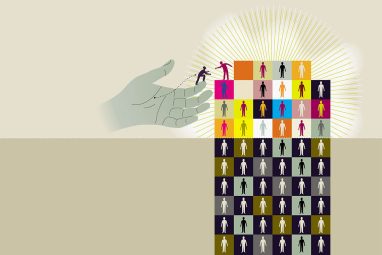Helping Others at Work Without Burning Out
To foster a sustainable culture of workplace helping, organizations should prioritize self-compassion and effective strategies for healthy collaboration.
Topics
News
- Ooredoo Launches Sovereign AI Cloud in Qatar Powered by Nvidia GPUs
- Dubai Future Foundation and WEF Release Top 10 Emerging Technologies of 2025
- Deloitte and AWS Forge $1 Billion Alliance to Accelerate Digital Transformation in the Middle East
- Over 40% of Agentic AI Projects Expected to Fail by 2027, Report Finds
- Guardian AI Agents Poised to Take 15% of Agentic AI Market by 2030, Gartner Says
- Deloitte Rolls Out Global Agentic Network to Accelerate AI Adoption in the Middle East

Creating a culture of helping in the workplace is beneficial for both organizations and employees. Companies are more productive and profitable when their employees help one another, and research has shown the many benefits of workplace helping, including higher morale and job satisfaction for both the help provider and receiver.
However, despite their best intentions, employees may sometimes fail to help one another due to a range of factors, including a lack of technical skills and social connections, time famine, and burnout. Many employees want to pitch in for their colleagues but may simply lack the time or energy to successfully follow through with their helping efforts.
We know that companies run better when employees help one another, but we know less about how helping failures affect both the organization and the employees involved. Research on workplace failures in general suggests that employees don’t always handle them well. Oftentimes, they lose confidence in their abilities and may become discouraged from trying to help again in the future.
Our recent research suggests that self-compassion may be key to navigating these helping failures. Self-compassion involves a mindset of patience and understanding toward ourselves, coupled with a balanced approach to our emotions and a reminder that everyone fails from time to time. Science has shown us that self-compassionate employees experience better performance and less burnout, among other benefits. As researchers, we were curious to test whether self-compassion plays a similarly beneficial role when employees face helping failures. (See “Examples of Failed Helping From the Research.”)
Examples of Failed Helping From the Research
“A coworker asked me to automate a process for him. I said I would see what I could do. Unfortunately, my coding skills were very green at the time, and not only did it take me a long time to work through the problem, I wasn’t able to solve the problem.” — Anonymous participant X
“I tried to help a coworker meet a deadline, but I ended up being too busy to participate. I offered to help early in the week, but as the week progressed, I had to take on additional work and no longer was able to assist.” — Anonymous participant Y
We conducted four studies that used both experimental and survey-based approaches to examine the effects of self-compassion on helping failures. In one study, we recruited 246 people employed across a wide range of industries and asked them to write about a time when they had tried to help a coworker but were unsuccessful. We then introduced a self-compassion intervention, with participants assigned to either the high or low self-compassion condition. Using a thought-listing exercise, they were asked to list thoughts that would either facilitate kindness (the high self-compassion condition) or harshness toward themselves (the low self-compassion condition). We then measured their feelings of guilt, confidence in their ability to help in the future, and intention to help in the future.
We found that a self-compassionate mindset reduced feelings of guilt and increased feelings of confidence in the participants’ ability to help. Employees who were kinder to themselves after a helping failure experienced more positive self-perceptions of themselves, thereby increasing their self-confidence in their ability to provide effective help, and in turn increasing future helping. However, it’s important to note that self-compassion also helped participants to feel lower levels of guilt, which reduces future helping. Thus, self-compassion has a nuanced effect on future helping.
So how should managers and organizations make sense of these findings? Our research suggests that self-compassion enables employees to offer help in a healthy and sustainable way that comes from a place of self-confidence but discourages help that comes from a place of guilt. The findings around guilt also illustrate how helping coworkers can sometimes be costly to employees. For instance, feeling pressured to help worsens employees’ stress levels and intentions to quit. There is also the danger of job creep, which happens when supervisors and peers come to view discretionary acts of help as part of the employee’s core job over time. Job creep and the toll that it has on employees are easy to miss, given that the expectations increase gradually over time. Ensuring that the boundaries between employees’ job duties and discretionary helping efforts are clearly defined necessitates that managers engage in frequent, open discussions with them about their job responsibilities.
In order to make workplace helping more effective and sustainable over the long term — by reaping the benefits without the harm — organizations should be proactive in nurturing employees to be better helpers. Importantly, employees with sufficient bandwidth are better poised to help. Research on IDEO, a global design company known for its culture of helpfulness, speaks to this. At IDEO, employees are able to effectively help their coworkers on a regular basis because they are not overloaded with core duties.
To ensure that employees have time available to help one another in a sustainable way, organizations need to provide slack within their roles. In addition, managers can coach employees on how to be better helpers by sharing effective helping strategies. For instance, clarifying one’s helping intentions (such as “I’m here to help, not judge or take over”) can set the stage for more productive helping. Also, help is often most useful to recipients when helpers take the time to understand what the recipients actually need rather than making assumptions about what they need.
Self-compassion enables employees to offer help in a healthy and sustainable way that comes from a place of self-confidence.
When helping efforts fall short, we recommend that managers encourage — and employees embrace — self-compassion. While it may not immediately increase helping behavior, self-compassion makes it more likely that employees’ helping efforts are coming from the right place, which in turn supports sustainable helping. It is worth noting that, despite its well-established benefits for performance and well-being, embracing self-compassion at work might be hard for some employees to do, since they might worry about being viewed as lazy or self-indulgent for practicing it.
Managers can nudge their organizations toward a culture of self-compassion by leading by example and practicing it themselves. In fact, recent research found that self-compassionate leaders help their employees with both their personal problems and work-related tasks more. When employees see their managers practicing self-compassion, they are more likely to embrace self-compassion themselves and learn to be better helpers. Of course, offering employees access to well-being programs and self-care services (such as mindfulness resources) provides them with options to strengthen their self-compassion muscles. However, the use of such resources should not be mandatory, and participation should be coupled with a genuine desire to cultivate self-compassion and well-being in the workplace.
In striving to be good organizational citizens, we often try our best to help our coworkers. Workplace helping is essential for organizational success, but it can be difficult to sustain in the face of burnout, time constraints, and other challenges. At a time when workforces are experiencing burnout at record levels, organizations can do more to foster a culture of self-compassion and ensure that employees have effective strategies for helping one another in healthy and sustainable ways. In doing so, organizations and managers can create an environment that is supportive, productive, and fulfilling for all.





